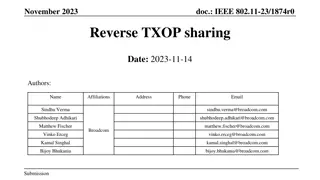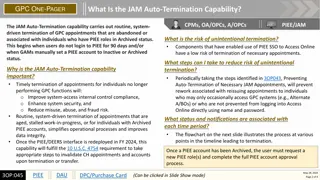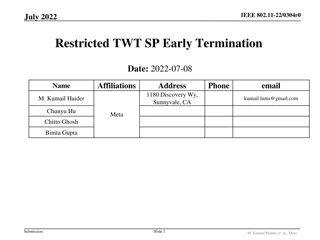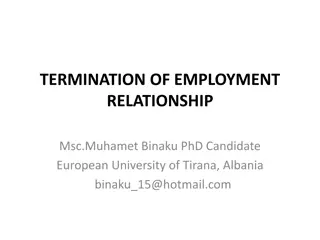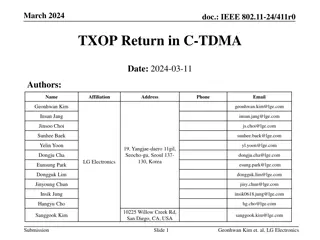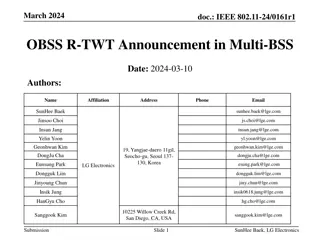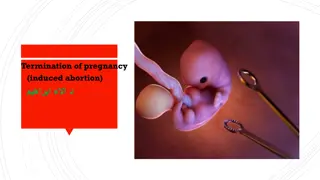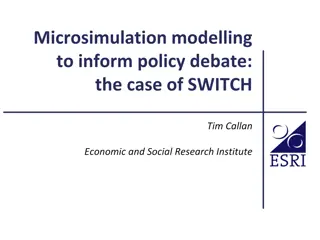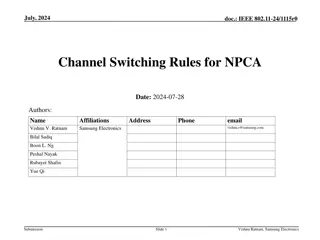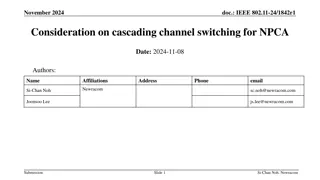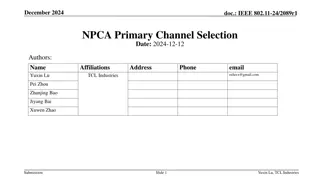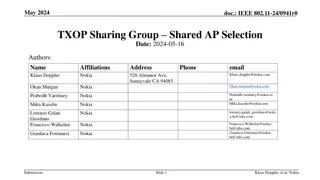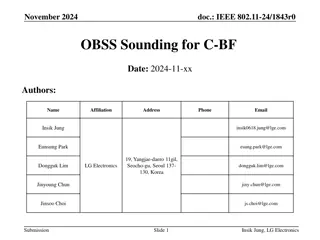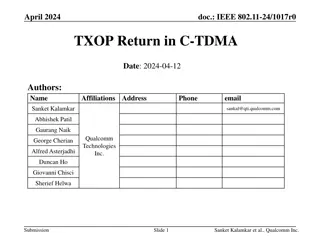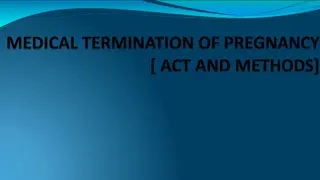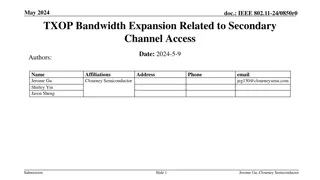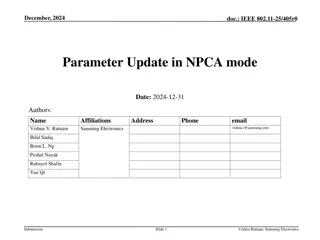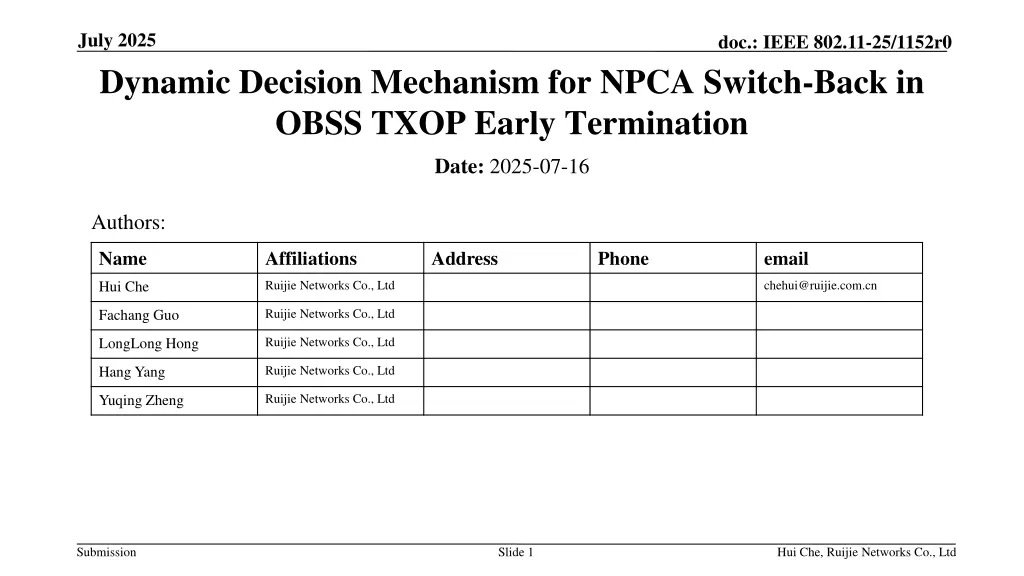
Dynamic Decision Mechanism for NPVA Switch-Back in OBSS
Explore a proposed dynamic decision mechanism addressing the challenges faced in NPVA channel switching-back scenarios during OBSS TXOP changes in IEEE 802.11 networks. The mechanism involves utilizing AP MLD with multi-link detection to optimize switch-back timing, thereby reducing invalid TXOPs effectively and synchronizing the process across different nodes.
Download Presentation

Please find below an Image/Link to download the presentation.
The content on the website is provided AS IS for your information and personal use only. It may not be sold, licensed, or shared on other websites without obtaining consent from the author. If you encounter any issues during the download, it is possible that the publisher has removed the file from their server.
You are allowed to download the files provided on this website for personal or commercial use, subject to the condition that they are used lawfully. All files are the property of their respective owners.
The content on the website is provided AS IS for your information and personal use only. It may not be sold, licensed, or shared on other websites without obtaining consent from the author.
E N D
Presentation Transcript
July 2025 doc.: IEEE 802.11-25/1152r0 Dynamic Decision Mechanism for NPCA Switch-Back in OBSS TXOP Early Termination Date: 2025-07-16 Authors: Name Affiliations Address Phone email Ruijie Networks Co., Ltd chehui@ruijie.com.cn Hui Che Ruijie Networks Co., Ltd Fachang Guo Ruijie Networks Co., Ltd LongLong Hong Ruijie Networks Co., Ltd Hang Yang Ruijie Networks Co., Ltd Yuqing Zheng Submission Slide 1 Hui Che, Ruijie Networks Co., Ltd
July 2025 doc.: IEEE 802.11-25/1152r0 Abstract Background: NPCA mechanisms (802.11bn) define switch conditions to NPCA channel but lack robust solutions for switch-back during dynamic OBSS TXOP changes. Problem: Existing methods (MAP coordination) fail when: OBSS TXOP ends early, causing inaccurate switch-back timing; AP/STA face different OBSS interference sources. Proposal: AP MLD uses multi-link to dynamically decide switch-back timing, reducing invalid TXOPs. Submission Slide 2 Hui Che, Ruijie Networks Co., Ltd
July 2025 doc.: IEEE 802.11-25/1152r0 NPCA Background & Gaps Current NPCA Framework (802.11bn): Switch to NPCA: Triggered by OBSS interference (bandwidth, duration, TA info). Switch-Back Rules: Motion #124: Defines NPCA switch/swich-back delays (0 252 s, 4 s resolution). Motion #126: Resets CW_NPCA[AC] and BO_NPCA when switching to NPCA channel. Identified Gaps: OBSS TXOP Early Termination: AP/STA on NPCA channel miss PCH OBSS TXOP end non-NPCA nodes initiate invalid TXOPs. Diverse OBSS Interference: AP and STA may switch due to different OBSS sources existing coordination method fails. Submission Slide 3 Hui Che, Ruijie Networks Co., Ltd
July 2025 doc.: IEEE 802.11-25/1152r0 Proposed Dynamic Decision Mechanism Core Idea: AP MLD uses multi-link to detect OBSS TXOP early termination and optimize switch-back timing. Key Components: Detection: Non-NPCA nodes (e.g., non-AP MLD on PCH) monitor OBSS TXOP status. Notification: OBSS early termination event + BSS Color sent via idle link (e.g., Link 2). Decision: AP MLD verifies BSS Color match triggers switch-back command to NPCA nodes. Submission Slide 4 Hui Che, Ruijie Networks Co., Ltd
July 2025 doc.: IEEE 802.11-25/1152r0 Example Scenario AP MLD3 AP MLD1 AP MLD2 OBSS interference OBSS interference OBSS interference ML OBSS interference ML non-AP MLD2 non-AP MLD1 Network Setup: AP MLD1 (Links: L1, L2), non-AP MLD1 (L1, L2), non-AP MLD2 (L1, L2). AP MLD2, AP MLD3. OBSS interference (from AP MLD2) on PCH triggers non-AP MLD1-L1 to switch to NPCA. OBSS interference (from AP MLD3) on PCH triggers AP MLD1-L1 to switch to NPCA. Non-AP MLD2-L1 remains on the PCH and does not switch to the NPCA channel. Mechanism Workflow: OBSS TXOP (from AP MLD2) ends early non-AP MLD2-L1 detects it on PCH. non-AP MLD2 sends the OBSS TXOP Early Termination notification (including BSS Color) to AP MLD1 via L2. AP MLD1 matches BSS Color commands non-AP MLD1-L1 to switch back via NPCA channel. Outcome: Prevents invalid TXOPs by synchronizing switch-back. Submission Slide 5 Hui Che, Ruijie Networks Co., Ltd
July 2025 doc.: IEEE 802.11-25/1152r0 Benefits & Implementation Notes Advantages: Efficiency: Reduces invalid TXOPs. Scalability: Works without AP cooperation. Robustness: Handles diverse OBSS scenarios. Implementation Considerations: BSS Color Matching: Ensures only relevant OBSS events trigger actions. Notification Channel: Use reserved/link 2 to avoid congestion. Fallback: If no non-NPCA node exists, revert to traditional methods. Submission Slide 6 Hui Che, Ruijie Networks Co., Ltd
July 2025 doc.: IEEE 802.11-25/1152r0 Summary Problem Addressed: Dynamic OBSS TXOP changes and heterogeneous interference break existing NPCA switch-back mechanisms. Solution: Multi-link notification + BSS Color verification dynamic switch-back decisions. Impact: Improves channel utilization, reduces collisions, and extends NPCA applicability to non-cooperative OBSS environments. Submission Slide 7 Hui Che, Ruijie Networks Co., Ltd
July 2025 doc.: IEEE 802.11-25/1152r0 References [1]11-24-1852-00-00bn, some-details-on-npca-operation , Ofinno, 2025. Submission Slide 8 Hui Che, Ruijie Networks Co., Ltd

